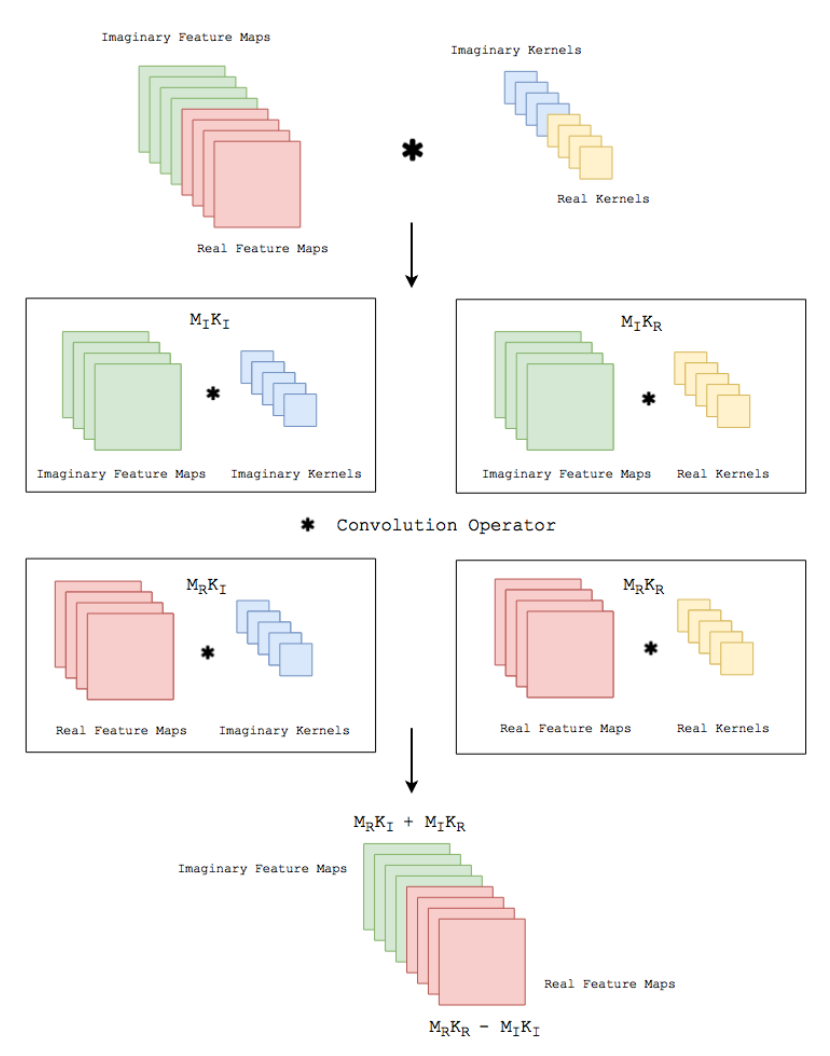Implementation and Math¶
Complex convolutional networks provide the benefit of explicitly modelling the phase space of physical systems [TBZ+17]. The complex convolution introduced can be explicitly implemented as convolutions of the real and complex components of both kernels and the data. A complex-valued data matrix in cartesian notation is defined as \(\textbf{M} = M_\Re + i M_\Im\) and equally, the complex-valued convolutional kernel is defined as \(\textbf{K} = K_\Re + i K_\Im\). The individual coefficients \((M_\Re, M_\Im, K_\Re, K_\Im)\) are real-valued matrices, considering vectors are special cases of matrices with one of two dimensions being one.
Complex Convolution Math¶
The math for complex convolutional networks is similar to real-valued convolutions, with real-valued convolutions being:
which generalizes to complex-valued function on \(\mathbf{R}^d\):
in order for the integral to exist, f and g need to decay sufficiently rapidly at infinity [CC-BY-SA Wiki].
Implementation¶
Solving the convolution of, implemented by [TBZ+17], translated to keras in [DC19]

we can apply the distributivity of convolutions to obtain
where K is the Kernel and M is a data vector.
Considerations¶
Complex convolutional neural networks learn by back-propagation. [SSC15] state that the activation functions, as well as the loss function must be complex differentiable (holomorphic). [TBZ+17] suggest that employing complex losses and activation functions is valid for speed, however, refers that [HY12] show that complex-valued networks can be optimized individually with real-valued loss functions and contain piecewise real-valued activations. We reimplement the code [TBZ+17] provides in keras with tensorflow , which provides convenience functions implementing a multitude of real-valued loss functions and activations.
[CC-BY [DLuthjeC19]]
- DC19
Jesper Soeren Dramsch and Contributors. Complex-valued neural networks in keras with tensorflow. 2019. URL: https://figshare.com/articles/Complex-Valued_Neural_Networks_in_Keras_with_Tensorflow/9783773/1, doi:10.6084/m9.figshare.9783773.
- DLuthjeC19
Jesper Sören Dramsch, Mikael Lüthje, and Anders Nymark Christensen. Complex-valued neural networks for machine learning on non-stationary physical data. arXiv preprint arXiv:1905.12321, 2019.
- HY12
Akira Hirose and Shotaro Yoshida. Generalization characteristics of complex-valued feedforward neural networks in relation to signal coherence. IEEE Transactions on Neural Networks and Learning Systems, 2012.
- SSC15
Andy M. Sarroff, Victor Shepardson, and Michael A. Casey. Learning representations using complex-valued nets. CoRR, 2015. URL: http://arxiv.org/abs/1511.06351, arXiv:1511.06351.
- TBZ+17(1,2,3,4,5)
Chiheb Trabelsi, Olexa Bilaniuk, Ying Zhang, Dmitriy Serdyuk, Sandeep Subramanian, João Felipe Santos, Soroush Mehri, Negar Rostamzadeh, Yoshua Bengio, and Christopher J Pal. Deep complex networks. arXiv preprint arXiv:1705.09792, 2017.